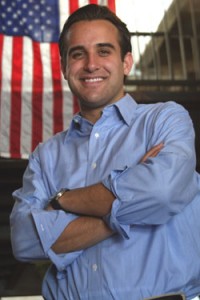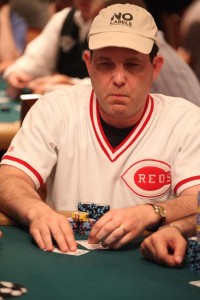By Saul Kaplan, on Mon Jul 7, 2014 at 8:30 AM ET  It’s time for me to come clean. In today’s social media crazed world it will come out sooner or later anyway. I have one high school varsity letter and it’s for bowling. Yes, you heard right, bowling. And it wasn’t ten-pin, but candlepin bowling. Anyone who grew up in New England, with parents like mine who looked for ways to get the kids out of their hair on rainy Saturdays, knows exactly what I’m talking about. Candlepin bowling rocks. It’s time for me to come clean. In today’s social media crazed world it will come out sooner or later anyway. I have one high school varsity letter and it’s for bowling. Yes, you heard right, bowling. And it wasn’t ten-pin, but candlepin bowling. Anyone who grew up in New England, with parents like mine who looked for ways to get the kids out of their hair on rainy Saturdays, knows exactly what I’m talking about. Candlepin bowling rocks.
For those of you who aren’t from New England, candlepin bowling is a unique version of the sport invented in 1880 in Worcester, Massachusetts by a local bowling alley owner, Justin White. Candlepin bowling is clearly evidence of New England as a regional innovation hot-spot. For the most part candlepin never caught on outside of New England and the Canadian Maritime provinces. In the region candlepin bowling enjoyed a cult following including its own local television shows. I remember Candlepins for Cash, which was a Saturday morning staple and may well have been the first reality television show.
The first noticeable difference from the more popular ten-pin variety of bowling is the small size of the balls. Don’t look for holes for your fingers because there aren’t any. The ball is 4 ½ ” in diameter weighing only 1.13 kg. It fits in the palm of your hand and can literally be thrown rather than rolled down the alley at the pins. I have seen many errant candlepin balls launched across lanes. Personal injury insurance is a must. Back in the day I owned a set of balls (spare me the cajones jokes) and yes of course the required bowling ball bag. The balls were a pearly white with wonderful lime green marble swirls throughout. Come to think of it I wonder where they went. Most likely my wife sold them at a garage sale when I wasn’t paying attention.
Another difference in candlepin bowling is the size of the skinny pins (15 ¾ ” by 3″) which are harder to knock down so you get three tries in every frame versus the two attempts you get in ten-pin. My favorite difference in candlepin bowling is that the deadwood between shots isn’t cleared. In other words pins that are knocked down are left as they lie to either impede or aid the subsequent shot in each frame. You haven’t lived until clearing a 7-10 split which would be all but impossible without the help of well-placed deadwood. I love this aspect of the sport and in this way candlepin bowling is like the innovation process and life. There is always deadwood to deal with. It is how you deal with and leverage the deadwood in your life that defines you.
Innovation is a better way to deliver value. It isn’t an innovation until value is delivered to an end-user in the real world. Innovators must figure out how to deal with deadwood. This ability often marks the difference between an innovator and a non-innovator. It isn’t the lack of ideas or technology that gets in the way it is stubborn humans and institutions that slow down or block experimenting with and scaling a better way. Most give up when deadwood is either blocking the way forward or it seems insurmountable and not worth the personal effort or risk. Innovators don’t give up and are never deterred. They incessantly find ways to go around or through deadwood. The most creative innovators find ways to leverage deadwood. They actually put it to use in exploring new and better ways to deliver value and solve problems. Innovators co-opt or repurpose people and capabilities to enable the innovation process. What looks like deadwood to most is just part of the solution for an innovator.
This is the secret of how innovators confidently attempt 7-10 splits when no one believes a proposed innovation is even possible. Innovators see ways to recombine capabilities in order to tackle the seemingly impossible. They are relentless in trying new permutations until some new combination works. Innovators have learned to leverage deadwood to find new ways to create, deliver, and capture value. This innovation junkie is proud of his bowling varsity letter. Bring on the deadwood.
By Matt Ranen, on Fri Jul 4, 2014 at 1:30 PM ET  When business leaders talk about the ‘race for talent,’ you naturally want to know more about where the contestants in that race are going to come from, and exactly how they are training for the race. The answer, at least in the US, has for a very long time belonged to the higher education sector. When business leaders talk about the ‘race for talent,’ you naturally want to know more about where the contestants in that race are going to come from, and exactly how they are training for the race. The answer, at least in the US, has for a very long time belonged to the higher education sector.
But there’s a significant disconnect here. Come June (graduation season) and then again come September (tuition check writing season), you can pick up any major newspaper and get even odds on finding an article or editorial that asks if a college education is worth the time and cost. If the race for talent were quite so intense, would anyone wonder about the value of college?
Today it’s absolutely fair to wonder. College education is one of the largest expenditures and investments that most people make in the course of their lives, with the possible exception of their primary real estate. These days, of course, a decent college education can cost a lot more than a decent apartment in most cities. And don’t forget the four (or more) years of opportunity cost, when the student is being a student and not something else that could earn him or her a salary.
And yet for a long time, at least in the United States, ‘is college worth it’ wasn’t even a question, or at least not a question you would pose in polite conversation. The economics of higher education seemed definitive: the more schooling you had, the more the labor market valued you and the more money you made over the course of your life (the only exception to that rule being non-professional PhD degrees). For most of the post-World War II period (and it’s still true today) a college degree was one of the best guarantees against unemployment during labor market downturns. And all of this, without even mentioning the inherent value of learning and socialization that happens during those four ‘wonderful’ years. Even electrical engineering students take a philosophy or art history course now and again, and human beings are indeed much more than simply labor market inputs. College was supposed to make them better at both.
Read the rest of…
Matt Ranen: LABOR MARKETS, HIGHER EDUCATION, AND THE RACE FOR TALENT
By Jonathan Miller, on Fri Jul 4, 2014 at 10:00 AM ET  As millions of Americans celebrate our nation’s birthday with parades, grill-outs and firecrackers, I will be stuck in a cavernous, over-air-conditioned, non-descript warehouse, leaning over cushioned tables with several hundred other exhausted, bleary-eyed (mostly) men. As millions of Americans celebrate our nation’s birthday with parades, grill-outs and firecrackers, I will be stuck in a cavernous, over-air-conditioned, non-descript warehouse, leaning over cushioned tables with several hundred other exhausted, bleary-eyed (mostly) men.
And having the time of my life.
Yes, in a few hours, we will begin Day 2 of the World Series of Poker’s “Little One for One Drop” tournament, and I’m still in the hunt. (Read more about the tournament and the incredible charity it supports in my Daily Beast report from last year’s event.)
Precisely, with over 14,000 chips, I’m in 529th place out of the 887 remaining players who have so far survived 10 hours through a field of more than 4400 poker-star wannabes. (Is it fitting that I built my political career around the creation of a 529 pre-paid tuition plan in Kentucky? Naahhhh.)
I am really lucky to be here, and that’s not just some Gehrig-like humility. A little over an hour into the event, I made the stupidest, most regrettable move that I have ever attempted in my three years of World Series events. I was dealt an Ace-10, and the flop revealed a 10, 8 and 6. The betting got intense, and a talky, charismatic Californian at the other end of the table with a larger stack than mine ultimately made a very large bet. I impulsively went all-in, having the top pair on the board (10s) and the biggest kicker (an Ace).
However, with all of the betting, I should have realized that I did not have the best hand. In retrospect, it was very possible that the Californian had flopped trips (three of a kind). Indeed, when he called me and turned over his cards, he held an 8-6, therefore having two pairs.
I was in serious danger of leaving the tournament VERY early. I thought I had 6 “outs” — there were 3 Aces and 3 tens left in the deck that could possibly save me. When the turn (fourth card) revealed a 4. I had one chance left. Finally, came the river. Praying in vain for an Ace or a 10, instead another 4 appeared. I got up thinking my tournament ended with a stupid mistake.
Then, the player to my right quickly informed me that I had just won. I was now the holder of two pair — tens and fours, and my two pair was larger than the Californians. I had doubled up through my stupid luck.
The poker miracle served also as a wake-up call. I became a lot more focused on my conservative/aggressive game (playing only the top hands and playing them with boldness) and played perhaps my best poker ever. I was up to over 20,000 chips, and was poised to jump to 26,000 until I got rivered in an all-in against a short stack. (He had only two cards that could save him from elimination, and one of them showed up.) Still, while the loss took me down to 14,000, I’m still very much in the game, starting today in a slightly below average stack position.
So, now it’s time for your help. Yesterday, I wore my lucky outfit — my Cincinnati Reds Joe Morgan jersey and No Labels ball cap. I’m wondering if I should wear it again (with different undergarments, of course!) — or if I should switch up to my Anthony Davis UK jersey or my Jeremy Lin Harvard jersey. Please provide your counsel in the comments below.
Meanwhile, if you need to get away from Fourth of July festivities, you can follow the action here at the WSOP Web site, starting at 4PM EDT/1 PM PDT.
By Will Meyerhofer, on Thu Jul 3, 2014 at 1:30 PM ET “I never thought I’d end up working as a contract attorney doing doc review in a windowless basement,” my client bemoaned. “But then I read that piece about the lawyer who’s working as a clerk at WalMart. At least I’ve still got it over him in terms of job prestige.”
 Well, you know how obsessed lawyers are with job prestige. Well, you know how obsessed lawyers are with job prestige.
There’s a phrase, “The Downward Drift,” that crops up in discussions of serious mental health diagnoses like schizophrenia, and/or chronic substance abuse. The idea is that you are afflicted with serious mental illness, or become addicted to a harmful substance, which in turn leads to a slow, inevitable slide downward in terms of social class. Before long, the wealthy, Upper East Side business executive suffering from schizophrenia and/or severe alcoholism finds himself jobless, friendless and eventually even homeless, sleeping in shelters and begging for change.
Weirdly, the same phenomenon – the Downward Drift – affects people who acquire Juris Doctor degrees. It sort of makes sense, since – at least nowadays, with people like me bellowing jeremiads on every street corner, it would be evidence of utter madness – textbook psychosis, perhaps – for anyone to head in the direction of law school, at least unless that law school is one of the top three in the country and someone else is footing the bill. But try to persuade a kid with a high LSAT score not to apply to law school – it’s nearly as tough as persuading a kid who’s gotten into a “top-500” (or whatever) law school into not attending (especially if he’s “won” one of those risible $20,000 so-called “scholarships” they hand out like pushers showering crack vials on newbie users.) If that task sounds Herculean (or Sisyphean), try talking a kid who’s blown $80,000 on his first year of law school out of “finishing up” the other two (useless) years – even if he’s hated every moment of the experience so far. This is where the parallel with addiction comes in because I guarantee you it’s no easier than convincing a chronic alcoholic that ten martinis is really enough. Even my own much-vaunted powers of persuasion come up short at that juncture. Because it’s impossible. An addict will keep drinking and drugging until he passes out face down in a puddle on the sidewalk. And a law student will blow that additional $160,000 to finish those two more pointless years. It’s a sure thing – just like zombies like eating flesh, the sun likes rising in the morning and Pat Robertson likes blaming bad weather on the homosexual agenda.
So how does the “Downward Drift” work, at least for lawyers?
Read the rest of…
Will Meyerhofer: The Downward Drift
By Jonathan Miller, on Wed Jul 2, 2014 at 2:16 PM ET  Yesterday’s $1500 no limit hold ’em tournament was a wild ride. For hours, I was grinding and grinding effectively, doubling, then tripling my stack. Yesterday’s $1500 no limit hold ’em tournament was a wild ride. For hours, I was grinding and grinding effectively, doubling, then tripling my stack.
Then, I was dealt the worst hand of all: Two Kings. Of course, two kings is the second best opening hand in all of hold ’em. But when one of your table mates is dealt the best hand — two Aces — you are in a whole mess of trouble.
When you are dealt two kings, you feel like the world is in your hands — and a whole mess of your opponents’ chips. You are in clearly a dominant position against any other hand, and when no ace appears on the flop, you are almost guaranteed to be in a heavily dominant position. You know, after all, your opponents only have a .45% chance of drawing aces. A mathematical game, you can’t operate so cautiously as to fear that slim a probability.
So when it happens, two kings are a killer. You have less than an 18% chance of prevailing.
And in my case, the odds held. And I was knocked out of the tournament.
Good news is that there’s another tournament that begins today, and it is one of my favorites: The Little One for One Drop. I wrote about last year’s event and the incredible “One Drop” global water charity it supports here. And I’m back for another try today.
I’ve also tried to change my luck with a new fashion strategy. Take a look at my outfit, and the first person who guesses my shirt fabric wins a prize.
Wish me luck. And hope that I don’t get two kings again.
By Brooke Masters, on Wed Jul 2, 2014 at 1:30 PM ET  The US financial regulatory system can be described as a bowl of spaghetti. Multiple watchdogs with overlapping jurisdictions routinely tangle with each other over how best to keep markets safe and honest. The US financial regulatory system can be described as a bowl of spaghetti. Multiple watchdogs with overlapping jurisdictions routinely tangle with each other over how best to keep markets safe and honest.
Financial groups routinely moan about the contradictory requests and soaring compliance costs that result.
This week, Eric Schneiderman, the New York attorney-general, reminded investors why the US system of competitive regulation can sometimes work in their best interests. Mr Schneiderman fired a warning shot on Wednesday into the murky world of dark pools – trading venues where investors buy and sell large blocks of shares anonymously, with prices posted publicly only after deals are done.
He alleged that Barclays’ pool, Barclays LX, favoured high-speed traders while misleading institutional investors.
Click here to read the rest of the piece in Financial Times.
By Jason Grill, on Tue Jul 1, 2014 at 3:00 PM ET  Growing up I always admired Michael Jordan. In my opinion, he is the best basketball player of all time. At the time he was playing professional basketball, I never imagined him making mistakes. But recently, I came across a quote where he said, “I’ve missed more than 9,000 shots in my career. I’ve lost almost 300 games. Twenty-six ties, I’ve been trusted to take the game winning shot and missed. I’ve failed over and over and over again in my life. And that is why I succeed.” Growing up I always admired Michael Jordan. In my opinion, he is the best basketball player of all time. At the time he was playing professional basketball, I never imagined him making mistakes. But recently, I came across a quote where he said, “I’ve missed more than 9,000 shots in my career. I’ve lost almost 300 games. Twenty-six ties, I’ve been trusted to take the game winning shot and missed. I’ve failed over and over and over again in my life. And that is why I succeed.”
Air Jordan couldn’t have said it better. Even the greatest fail in some aspects of their career or business along their way to success.
Although MJ’s sentiment is spot on, here are three mistakes to avoid when building your business.
1. Assuming Growing Big Fast Is Best
Many people believe that quickly growing their company with numbers and employees is always a great thing and will make them more successful. But this isn’t always the case. Many times people learn this the hard way and fail fast after thinking that having a lot of people in-house would make them more profitable and successful. They fail financially and have smaller profits because of all the other costs involved.
As a small business owner, it often makes more sense to build strategic partnerships and mutually beneficial relationships. This allows you to keep your overhead costs lower and not have the stress of numerous employees as you begin to grow your profits. You won’t have to worry about everything else. Working with other businesses that might be bigger or offer more back-end support allows you to do what you do best, while at the same time utilizing the strengths of the other partner companies. Growing your business with key partners is often way more profitable than growing fast within.
2. Never Saying the Word “No”
As a small business owner and entrepreneur, it’s always tough to say or use the word “no.” As you begin your business, you want to be everywhere and be everything to potential clients. It’s very hard not to do this when you start out. If your business is somewhat successful, even at an early stage, you will be asked many times to coffees, lunches and events. At some point you have to say no to some people, free services and advice or meetings in order to continue to move forward with your business. On the flip side of the coin: you must say no to potential clients or projects you don’t want to really work on.
I understand as a small business it’s sometimes hard to say no to a decent paycheck and short-term reward, but if you don’t, you will regret it. Saying no to projects or clients your heart isn’t into, or your mind isn’t truly focused on, will allow you to work on those opportunities you really enjoy. This will allow you to leverage your strengths more. You will produce a much better product and your work will be stronger. Walking away from something in the short term will help you build the portfolio you want over the long term.
3. Planning Too Much
Small business owners often want to plan out every little thing, from the top to the bottom. We want to control everything and make sure it’s exactly what we had in our original plan. As a result, we find ourselves spending all our time planning out the future instead of being mindful of the present.
Why do these small business plans fail? They fail because too much time is spent on process and plan and not on execution. The Harvard Business School says 90 percent of well-formulated strategies fail due to poor execution. Fortune Magazine says 70 percent of CEO failures come not as a result of poor strategy, but from poor execution. As small business owners, it’s always good to remember to iterate and to not ever hesitate. Execution trumps devising another elaborate, time-consuming process or plan every time.
Life is a journey, not a destination. Mistakes are going to happen along the way. Always remember: if you don’t experience mistakes you will never learn what success can be. Don’t dwell on your business failures; instead, learn from your mistakes, be resilient and persevere.
A version of this article originally appeared in The Huffington Post.
@JasonGrill is the founder of JGrill Media is the founder of JGrill Media where he consults on media relations, public affairs and strategies and government relations. Under same umbrella, he works in the media as a local and national writer/contributor, radio host and television analyst/commentator. He is the co-founder of Sock 101. where he consults on media relations, public affairs and strategies and government relations. Under same umbrella, he works in the media as a local and national writer/contributor, radio host and television analyst/commentator. He is the co-founder of Sock 101.
By David Goldberg, on Tue Jul 1, 2014 at 1:30 PM ET  Hemingway had it mostly right: “When people talk, listen completely. Most people never listen.” Hemingway had it mostly right: “When people talk, listen completely. Most people never listen.”
I’d actually take it a step further: most people never ask.
To be an effective leader, it’s crucial to develop a culture where employees feel consistently heard, and that their feedback is having an impact on the organization. A simple way to do this is to just start asking.
Think about it: how often do you ask your significant other, child, family members and friends, “How are you doing?” It’s probably more than once a year. Curiously, we don’t follow the same construct in the workplace. We usually only ask employees once a year.
Most companies typically do this through an annual employee survey, or worse, water cooler discussions at executive meetings where conjecture and subjective opinions are offered on how people are “feeling.” Multiple studies have proven that this type of infrequent, ad hoc means by which most solicit feedback from their workforce has an extremely negative impact on employee engagement. It’s probably why, in its 2013 State of the Global Workplace report, Gallup found only 13% of employees worldwide are engaged at work – a ridiculously low number.
Last year, we surveyed HR leaders in Silicon Valley to find out how they were keeping their employees happy, healthy and heard. Five key themes emerged:
-
Money does matter
-
Hands-on approach is key
-
Employees want a voice
-
Employees must feel valued
-
Environment must be comfortable and positive
What’s interesting about the results is that 4 out of the 5 themes are centered on nurturing and building culture. This tells us that to really help employees thrive, listen to them. And, not just once a year. Culture isn’t an accident. It takes constant nurturing and work. One way to measure the health of your culture is through a series of employee engagement surveys.
At SurveyMonkey, we still do our annual employee survey. But we do it to identify a few key topics to explore deeper throughout the year. Then every three months, we solicit specific topic feedback and share the results with the team. For example, health benefits were an area that employees identified in the annual survey that they’d like improved. We followed up that annual survey with a specific benefits survey to all employees, and adjusted our offerings accordingly. The employees are part of the decision, feel heard, and we all feel a little bit wiser in the process. This ongoing survey dialogue allows your team leaders the ability to quickly identify issues and celebrate wins in real-time, not just once a year.
One parting word of wisdom. Don’t ask about things you’re not willing to change. Ignoring feedback is a sure way to disillusion a workforce. So, if you can’t change something, don’t ask. What you can change, involve employees. It will help build a healthy, thriving culture where everyone feels engaged and assured that their feedback has meaningful impact. So be wise. Stop talking. Ask and listen.
The author is the Founder and CEO of Survey Monkey
By Saul Kaplan, on Mon Jun 30, 2014 at 8:30 AM ET  One of the great things about having the kids around the house this summer is the temporary return of snack food. But this summer is different; the snacks are all lined up in the cupboard in 100-calorie bite size packages. As if the packaging alone will ensure portion control and make snacking consistent with our attempts at healthy living. Of course it only works if you stop with one 100-calorie package, which I seldom do. While snacking I have been thinking about the idea of bite size packaging and wondering if breaking up big hairy social goals into 100-calorie bite size packages of work tasks would better enable us to harness the power of social media to get more stuff done. One of the great things about having the kids around the house this summer is the temporary return of snack food. But this summer is different; the snacks are all lined up in the cupboard in 100-calorie bite size packages. As if the packaging alone will ensure portion control and make snacking consistent with our attempts at healthy living. Of course it only works if you stop with one 100-calorie package, which I seldom do. While snacking I have been thinking about the idea of bite size packaging and wondering if breaking up big hairy social goals into 100-calorie bite size packages of work tasks would better enable us to harness the power of social media to get more stuff done.
Social media platforms like Twitter and Facebook are incredible at stirring up the pot but not as good at serving the meal. I have been amazed at the way social media enables the exchange of ideas. The school doors are open 24/7 for life long learning. Diverse communities of interest arise spontaneously reacting to world events, spectacles, and provocative ideas. But how do we translate interest and commentary into action?
I am fortunate to interact every day with passionate and motivated innovators who agree that we must transform our health care, education, and energy systems. We also agree that the technology we need is available today to enable transformative change. This is our window of opportunity. Tweaking the current systems won’t work. We need real systems change and the key will be to unleash the power of social media beyond exchanging ideas to taking meaningful action. What if we could make it as easy to take an action step, as it is today to contribute and react to ideas? The way forward is to break these seemingly overwhelming social tasks down in to bite size 100-calorie packages so that social media enabled communities can engage by rolling up their sleeves and contributing deliverables that will advance these important causes.
We have to get better at asks. Asks have to be simple. Asks must be accessible at the point of interest. Asks should not require more than 140 characters. It has to be easy to say yes and to accomplish the bite size task. There should be immediate feedback on all completed tasks and it must be clear how the task fits into the bigger picture contributing to the overall social objective and systems change.
Social media platforms have the potential to move beyond talking about changing the world to actually enabling us to change it. We can accelerate progress by breaking down wicked goals in to 100-calorie bite size packages that are easier to snack on.
By Jonathan Miller, on Sun Jun 29, 2014 at 1:10 PM ET 
As The RP heads to Vegas for a return trip to play in he World Series of Poker (read here about his improbable journey to the 2012 Final Table), he talks to his friend — and nationally-renowned mental fitness coach — Jim Fannin for some critical pre-tourney advice.
Jim’s advice about how The RP can get “into the zone” — a strategy that Fannin has used to advice some of the world’s most famous professional athletes — can help you better yourself at poker…and in any other aspect of life.
Read about Jim here. And here.
And listen in to their 30 minute poker coaching session…
The RP HIGHLY RECOMMENDS Jim Fannin to his friends looking for an edge in business, sports or any other competitive field. Contact him here.
|
The Recovering Politician Bookstore
|
 It’s time for me to come clean. In today’s social media crazed world it will come out sooner or later anyway. I have one high school varsity letter and it’s for bowling. Yes, you heard right, bowling. And it wasn’t ten-pin, but candlepin bowling. Anyone who grew up in New England, with parents like mine who looked for ways to get the kids out of their hair on rainy Saturdays, knows exactly what I’m talking about. Candlepin bowling rocks.
It’s time for me to come clean. In today’s social media crazed world it will come out sooner or later anyway. I have one high school varsity letter and it’s for bowling. Yes, you heard right, bowling. And it wasn’t ten-pin, but candlepin bowling. Anyone who grew up in New England, with parents like mine who looked for ways to get the kids out of their hair on rainy Saturdays, knows exactly what I’m talking about. Candlepin bowling rocks.










 is the founder of
is the founder of 




